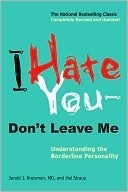More on this book
Community
Kindle Notes & Highlights
Read between
October 24 - November 27, 2021
This view hypothesizes that the limbic system, the part of the brain most closely associated with emotional responses, is hyperactive in the borderline. The second contributing factor, according to DBT practitioners, is an invalidating environment; that is, others dismiss, contradict, or reject the developing individual’s emotions. Confronted with such interactions, the individual is unable to trust others or her own reactions. Emotions are uncontrolled and volatile.
STEPPS is a group therapy paradigm, without individual sessions. It is also designed to be shorter—consisting of twenty two-hour weekly groups (compared to the typical one-year commitment expected in DBT).
STEPPS embodies three primary components: 1. Sessions educate about BPD and schema
2. Skills to better control emotions, such as problem management, distracting, and improving communication, are taught.
3. The third component teaches basic behavioral skills, such as healthy eating, healthy sleep regimen, exercise, and goal setting.
SFT combines elements of cognitive, Gestalt, and psychodynamic theories.
schema is defined as a worldview developed over time in a biologically vulnerable child who encounters instability, overindulgence, neglect, or abuse. Schemas are the child’s attempts to cope with these failures in parenting.
SFT attempts to challenge these distorted responses and teach new ways of coping through a process denoted as re-parenting.7
Mentalization, a term elaborated by Peter Fonagy, PhD, describes how people understand themselves, others, and their environment.
The term overlaps with the concept of psychological mindedness (understanding the connection between feelings and behaviors) and mindfulness (a goal in DBT; see above). Fonagy theorizes that when the normal development of mentalization beginning in early childhood is disrupted, adult pathology develops, particularly BPD.
When the child is unable to bond appropriately with a parent, he has difficulty understanding the parent’s or his own feelings.
TFP acknowledges the role of biological and genetic vulnerability colliding with early psychological frustrations.
Identity diffusion suggests a perception of oneself and others as if they were fuzzy, ghostlike distortions in a fun-house mirror, barely perceptible and insubstantial to the touch.
Another feature of BPD is persistent splitting, dividing perceptions into extreme and opposite dyads of black or white, right or wrong, resulting in the belief that oneself, another, or a situation is all-good or all-bad.
The borderline is stuck at an immature level of functioning. Feelings of emptiness, severe emotional swings, anger, and chaotic relationships result from this black-and-white thinking.
A significant subset of borderline patients have experienced a history of head trauma, encephalitis, epilepsy, learning disability, EEG (electroencephalogram, or brain wave) abnormalities, sleep pattern dysfunction, and abnormal, subtle neurologic “soft signs.”6,7
antidepressants, mood stabilizers, and neuroleptics (antipsychotics)—ameliorate many of the maladaptive behaviors associated with the disorder.9
Homeopathic or herbal treatments have generally been unsuccessful, with the exception of omega-3 fatty acid preparation.
The FDA (Food and Drug Administration) has not formally approved any drug for the treatment of BPD, so all of the medicines commonly used for treating BPD are considered “off-label.”
Unable to see his world through adult eyes, the borderline continues to experience life as a child—with a child’s intense emotions and perspective.
The borderline’s greatest obstacle to change is his tendency to evaluate in absolute extremes. The borderline must either be totally perfect or a complete failure; he grades himself either an A+ or, more commonly, an F.
The borderline, like many people, is sometimes paralyzed by indecisiveness.


